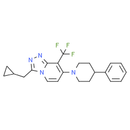Description
JNJ-42153605 is a potent and selective mGlu2 receptor PAM with an acceptable pharmacokinetic profile in rodent and nonrodent species. JNJ-42153605 showed centrally mediated in vivo effectivity in models sensitive to mGlu2 receptor modulation such as sleep−wake electroencephalogram (sw-EEG) in rats, 34 showing suppressed REM sleep during the first 4 h after oral administration of a 3 mg/kg dose.
Product information
CAS Number: 1254977-87-1
Molecular Weight: 400.44
Formula: C22H23F3N4
Chemical Name: 3-(Cyclopropylmethyl)-7-(4-phenyl-1-piperidinyl)-8-(trifluoromethyl)[1, 2, 4]triazolo[4, 3-a]pyridine
Smiles: FC(F)(F)C1=C(C=CN2C1=NN=C2CC1CC1)N1CCC(CC1)C1C=CC=CC=1
InChiKey: BQAVZGJJQFJSMW-UHFFFAOYSA-N
InChi: InChI=1S/C22H23F3N4/c23-22(24,25)20-18(10-13-29-19(14-15-6-7-15)26-27-21(20)29)28-11-8-17(9-12-28)16-4-2-1-3-5-16/h1-5,10,13,15,17H,6-9,11-12,14H2
Technical Data
Appearance: Solid Power
Purity: ≥98% (or refer to the Certificate of Analysis)
Solubility: DMSO: 4 mg/mL(9.98 mM).
Shipping Condition: Shipped under ambient temperature as non-hazardous chemical or refer to Certificate of Analysis
Storage Condition: Dry, dark and -20 oC for 1 year or refer to the Certificate of Analysis.
Shelf Life: ≥12 months if stored properly.
Stock Solution Storage: 0 - 4 oC for 1 month or refer to the Certificate of Analysis.
Drug Formulation: To be determined
HS Tariff Code: 382200
How to use
In Vitro:
JNJ-42153605 is found to not have agonist or antagonist activity toward other mGlu receptor subtypes up to 30 μM (>50-fold vs mGluR2) and also shows no or negligible affinity or activity at any of the targets in the CEREP panel of receptors (>100-fold selectivity for mGlu2 receptor).
In Vivo:
In mice, JNJ-42153605 dose-dependently and significantly attenuates the increase in locomotor activity induced by phencyclidine (PCP, 5 mg/kg sc) with an ED50 of 5.4 mg/kg sc. JNJ-42153605 shows a rapid rate of absorption from the gastrointestinal tract, reaching the maximal concentration after 0.5 h. Clearance in vivo is moderate to high in both rat and dog (35 and 29 mL/min/kg, respectively). Elimination halflives are on the shorter side across the species, being 2.7 h in rat and 0.8−1.1 h in dog. Volume of distribution is slightly higher than total body water, indicating distribution outside the plasma. Bioavailability is low to moderate across the species (35% in rat and 18−33% in dog).
References:
- Cid JM, et al. J Med Chem. 2012, 55(20):8770-89.
Products are for research use only. Not for human use.
Payment & Security
Your payment information is processed securely. We do not store credit card details nor have access to your credit card information.


